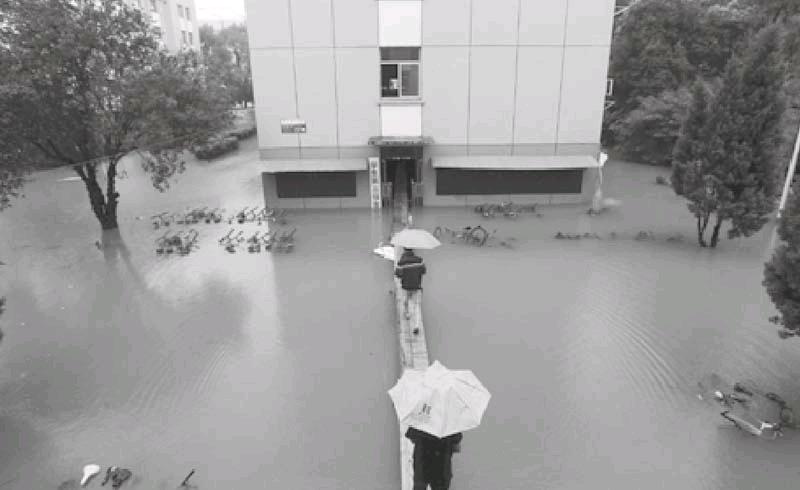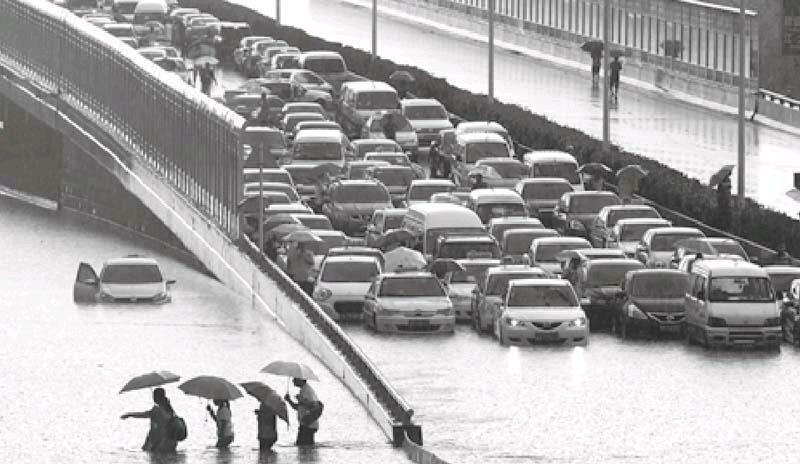China to Build‘Sponge Cities’to Address Urban Waterlogging
China will try to turn its cities into “sponges” to better absorb rain following several fatal bouts of urban inundation in recent years, the State Council said in September.
A campaign called “sponge city” will see the construction of high-level urban sewer systems during renovation work and new roads, residences, industrial parks and public green areas, according to a statement released after a State Council executive meeting.
The sewer system will drain rain water quickly and guide it to collection facilities for recycling.
The government encourages private investors to participate in the construction of the new sewer systems and asks financial institutions to provide support.
Heavy rain often results in floods in cities with outdated sewer systems.
In one case, 79 people died in Beijing after a rainstorm on July 21, 2012.
Logistics Park Learns About ‘Sponge City
The International Trade and Logistics Park in Xian, Shaanxi province, arranged a lecture on Aug 28 to give officials a better understanding of the national “Sponge City”initiative.
“Sponge City” is a national project that has been launched to make full use of rainwater potential in terms of both energy and conservation.
Huang Ningjun, a technical expert for the project was invited to detail the definition and connotation of “Sponge City”. Huang also outlined the parks construction plans in es- tablishing itself as a “Sponge City” by citing successful cases.
800 Million Yuan Invested on Yuelai Sponge City Project
Approximately 800 million yuan ($128 million) will be invested in the construction of a pilot “sponge city” project in Yuelai New District, Chongqing, according to the Liangjiang New Area. The project will form part of a comprehensive multi-functional urban district in Liangjiang New Area.
Chongqing was listed as one of the first batch of pilot cities to construct a “sponge city” this April, together with 15 other cities. The sponge city project will be built in Yuelai New District over the next three years.
Yang Zhihong, director of the Liangjiang construction bureau, said that the 800 million yuan ($128 million) investment will be used to rebuild eight roads and renovate the Chongqing international Expo Center and its surroundings, which covers 400,000 square meters.
As a mountain city with a unique pattern of rainfall, the biggest challenge for the project in Yulei New District is to find a tailor-made way of constructing a sponge city, according to Yang. He added that “the key to it is to make clear of the characteristics of the citys rainfall.”
The success of the sponge city pilot project in Yuelai New District will set a good example to Liangjiang New Area and wider areas in the Chongqing municipality.
‘Sponge City is Green, Smart and Will Rule in Future
Water as a resource is irreplaceable. Yet heavy rainfall can become a disaster even in modern cities if rainwater is not drained out in time. This was recently evident in Shanghai, Nanjing and some other cities, especially in southern China, where streets looked more like the canals of Venice.
The idea of “sponge city”, which emerged in the West and is gradually gaining popularity in China, will hopefully solve this problem. Following the philosophy of “solving a citys problems with its own resources”, it aims at storing rainwater, especially during heavy rainfall, to prevent floods and release it for the benefit of residents during dry times. This will also ease a citys water shortage.
The water distributive system has three main parts. First, it encourages the cultivation of “wetlands” and “meadows” in urban gardens, which will help collect water in pools, enable trees and plants to hold water, and replenish the underground water table. In case of water shortage, the water in the pools can be used directly, while more plants mean higher humidity and evaporation which will eventually lead to higher precipitation levels.
Second, buildings can collect rainwater, recycle it and save it in tanks or underground reservoirs. Data show that if all the prominent buildings in a city install a system to recycle and save rainfall, the rate of water flowing to the ground during heavy rainfall and thunderstorms could drop by 80 percent.
And third, a sponge community will combine pools, urban “meadows” and “wetlands”, and sponge buildings within one whole system. This is a particularly beneficial idea for China which has a tradition of living with nature - gardens are considered an indispensable part of traditional Chinese architecture. Pools, open green spaces and trees are key elements of traditional Chinese compounds, all of which help save water.
Sponge cities save water and, therefore, are more envi- ronmentally friendly. Some cities in foreign countries have not only adopted the idea of sponge gardens, but also built sponge squares. Unlike metaled squares that prevent water from replenishing the underground water table, these sponge squares have plants and well-designed pipelines that help store large volumes of water under the Earths surface. Chinese cities too can benefit by changing its metaled or tile-bedded squares to sponge squares.
Sponge cities will also reduce pollution. Studies show that rainwater flow in the first 30 minutes is exceptionally muddy because it carries the dust from buildings and roads. The mud, considered a waste by humans, is good nutrition for plants and meadows. Trees, plants and grass filter absorb the mud and thus filter the water that flows to the underground water table. And good rainfall helps cities save piped water that they use to clean the streets.
In more ways than one a sponge city will be a smart city. Urban management officials can install devices across a city to collect real data on rainfall, ground and underground flow of water, and amount of pollutants, which they can use to deal with emergencies.
A sponge city follows the philosophy of innovation: that a city can solve water problems instead of creating them. In the long run, sponge cities will reduce carbon emission cities and help fight climate change. The idea of green cities will rule in the future and sponge cities will be part of it.

